
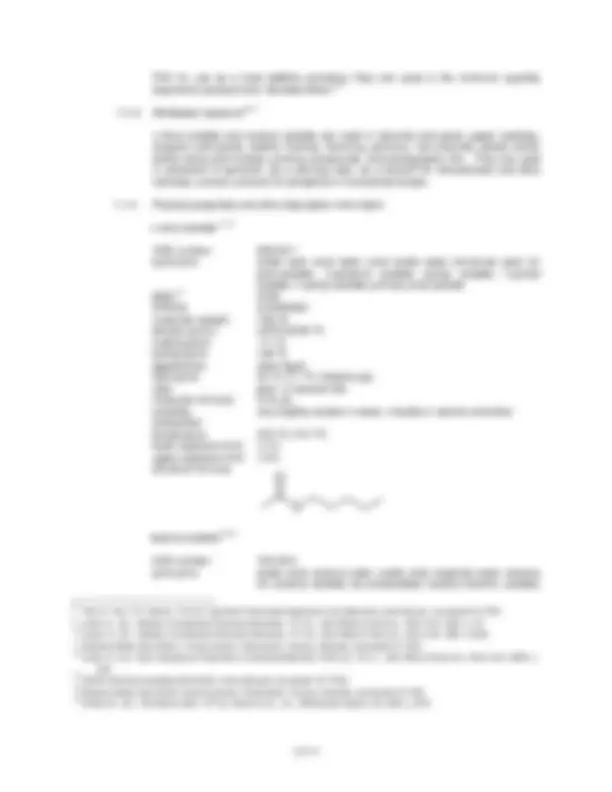
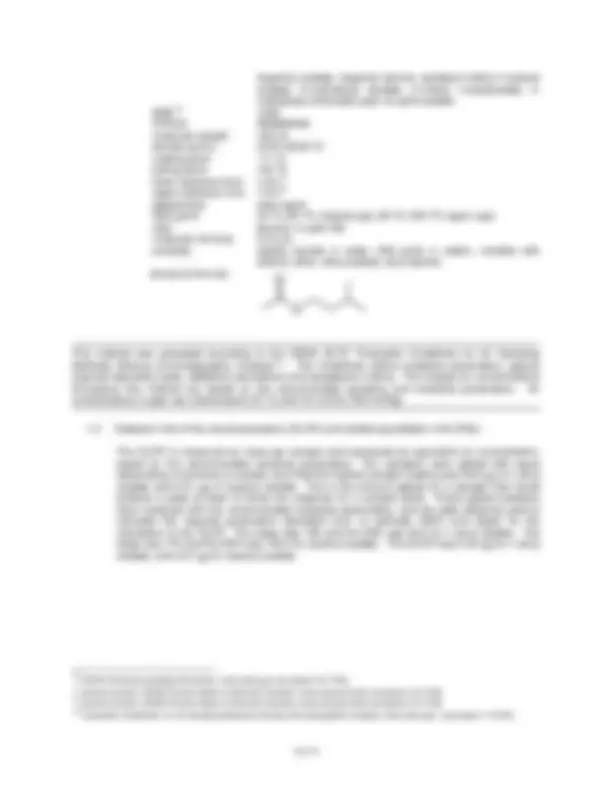
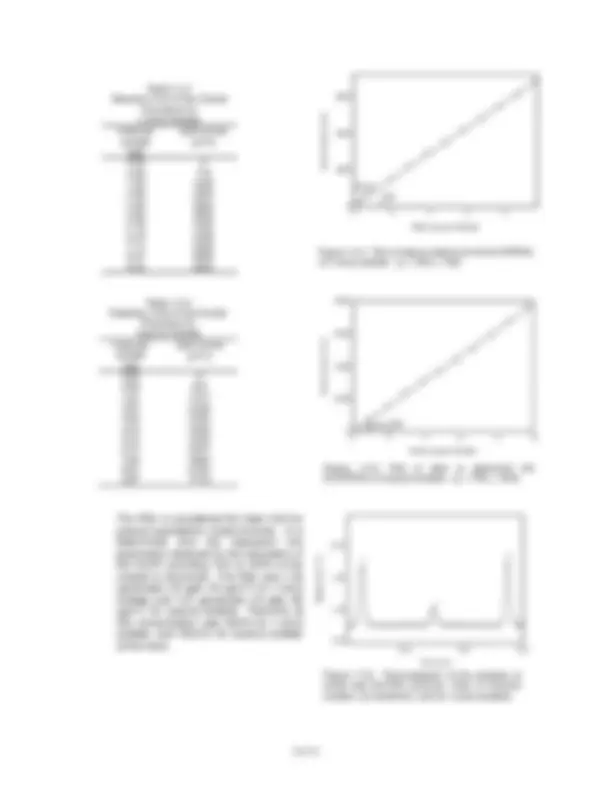
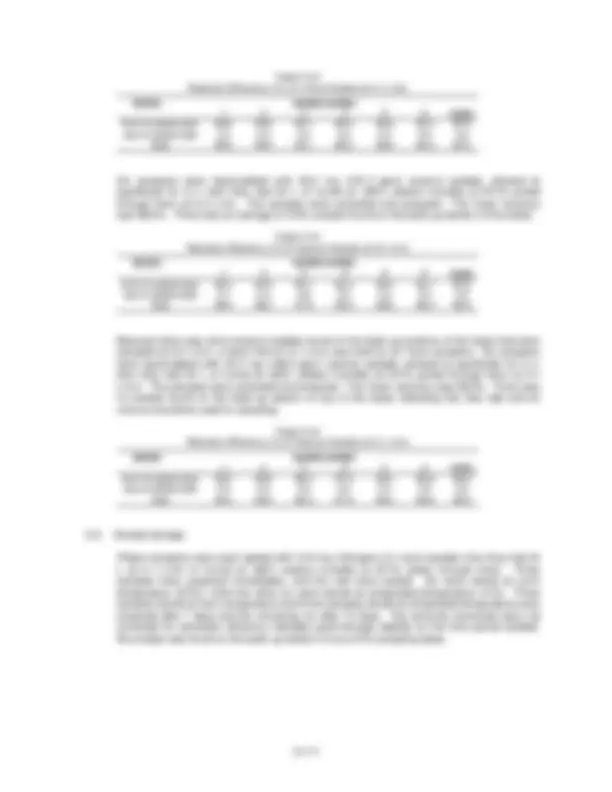
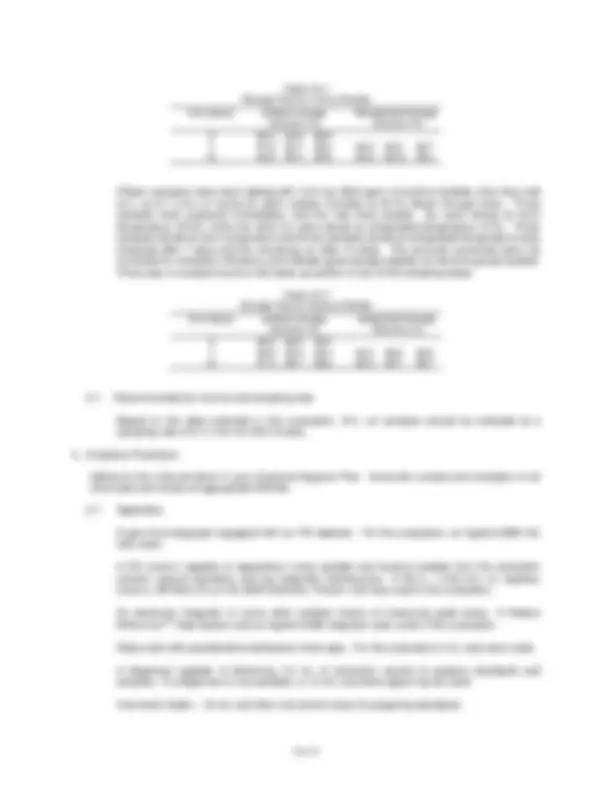
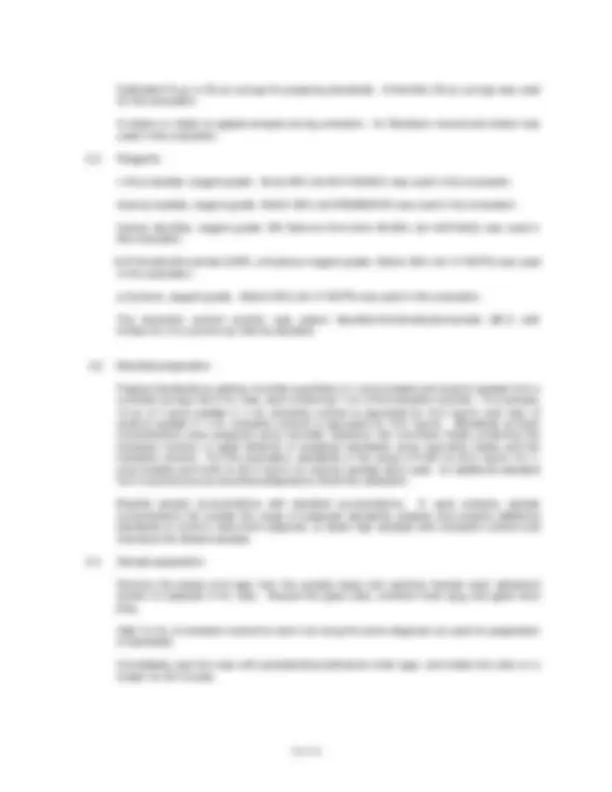
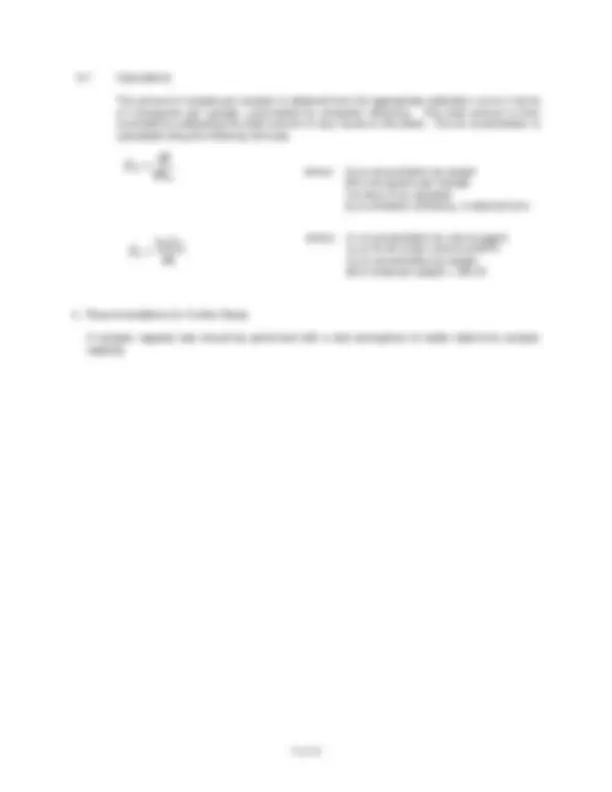


Study with the several resources on Docsity

Earn points by helping other students or get them with a premium plan


Prepare for your exams
Study with the several resources on Docsity

Earn points to download
Earn points by helping other students or get them with a premium plan
Community
Ask the community for help and clear up your study doubts
Discover the best universities in your country according to Docsity users
Free resources
Download our free guides on studying techniques, anxiety management strategies, and thesis advice from Docsity tutors
Information on the analysis of amyl acetates, specifically n-amyl acetate and isoamyl acetate. It covers sampling methods, detection limits, and retention efficiencies. details on the recommended sampling time and rate, reliable quantitation limits, and physical properties of the compounds.
Typology: Study notes
1 / 13

This page cannot be seen from the preview
Don't miss anything!








n-Amyl Acetate Isoamyl Acetate
Method no: PV
Control no.: T-PV2142-01-0502-CH
Target concentration: 100 ppm (525 mg/m^3 ) (n-amyl acetate) 100 ppm (525 mg/m^3 ) (isoamyl acetate) OSHA PEL: 100 ppm (525 mg/m^3 ) (n-amyl acetate) 100 ppm (525 mg/m^3 ) (isoamyl acetate) ACGIH TLV: 50 ppm (TWA) 100 ppm (STEL) (all isomers of pentyl acetate)
Procedure: Samples are collected by drawing workplace air through glass sampling tubes containing coconut shell charcoal with personal sampling pumps. Samples are extracted with a mixture of 99:1 carbon disulfide: N,N - dimethylformamide and analyzed by GC using a flame ionization detector (GC/FID).
Recommended sampling time and sampling rate: 240 min at 0.1 L/min (24 L)
Reliable quantitation limit: 10 ppb (55 μg/m^3 ) n-amyl acetate 15 ppb (80 μg/m^3 ) isoamyl acetate
Status of method: Partially validated method. This method has been subjected to established evaluation procedures of the Methods Development Team and is presented for information and trial use.
February 2005 Mary E. Eide
Chromatography Team Industrial Hygiene Chemistry Division OSHA Salt Lake Technical Center Sandy UT 84070-
For assistance with accessibility problems in using figures and illustrations presented in this method, please contact OSHA Salt Lake Technical Center (OSHA SLTC) at (801) 233-4900.
1.1 Background
1.1.1 History
Air samples collected using coconut shell charcoal tubes were received at OSHA SLTC with requested analysis for n-amyl acetate and isoamyl acetate. These two compounds are isomers and often occur together in the same workplace, under the name of amyl acetate. The samples were analyzed following NIOSH methods S isoamyl acetate^1 and S51 n-amyl acetate^2. There were concerns from OSHA industrial hygienists that they could smell n-amyl acetate and isoamyl acetate in the workplace, and yet the results reported from SLTC were below the PEL. The NIOSH methods did not include humid air retention studies or storage stability studies. This work was performed to determine if there was a problem with retention on charcoal sampling tubes and/or with storage. After the storage and retention studies were completed, NIOSH published a revised method that included the additional studies, Method 1450 Esters 1.^3 The breakthrough study using dry air was 34.3 L (871 mg/m^3 atmosphere) for n-amyl acetate and 32.3 L (874 mg/m^3 atmosphere) for isoamyl acetate. The storage study was performed with a loading of 140 μg on dry tubes with storage at 4 °C. Most workplaces have some humidity in the air, and water may affect the collection and storage, so it was decided to complete the work for this method. The retention and storage studies showed good recoveries, so the low results on field samples versus the expectation of high results were due to the strong odor of these compounds. The odor is of bananas or pears, and the odor threshold is 0.051 ppm for n-amyl acetate and 0.0034 ppm for isoamyl acetate.
A special thanks to Gene Brownson who did most of the analyses on the tests performed in this evaluation.
1.1.2 Toxic effects (This section is for information only and should not be taken as the basis of OSHA policy.)
n-Amyl acetate and isoamyl acetate are moderately toxic by intraperitoneal administration and are contact irritants affecting the skin, eyes, and respiratory system. Skin contact may cause dermatitis, higher exposure causes necrosis.4,5^ Eye contact with high concentrations may cause temporary impairment of vision and/or transient eye inflammation and ulceration. Inhalation of high concentrations can cause lung irritation, coughing, nausea, central nervous depression resulting in headache and dizziness, slowing of reflexes, fatigue and lack of coordination. Liver and kidney damage may result from massive exposures.6,7^ Isoamyl acetate has been approved by
(^1) NIOSH Manual of Analytical Methods, 2nd (^) ed.; Cincinatti, OH, Vol. 2, Method S45. (^2) NIOSH Manual of Analytical Methods, 2nd (^) ed.; Cincinatti, OH, Vol. 2, Method S51. (^3) NIOSH Method 1450 Esters 1, www.cdc.gov/niosh, (accessed 5/15/03). (^4) Lewis, R., Ed., Sax’s Dangerous Properties of Industrial Materials, Tenth ed.; John Wiley & Sons Inc.: New York, 2000, Vol. 3, p
(^5) Lewis, R., Ed., Sax’s Dangerous Properties of Industrial Materials, Tenth ed.; John Wiley & Sons Inc.: New York, 2000, Vol. 3, p
(^6) Material Safety Data Sheet: n-Amyl acetate, Chemwatch, Victoria, Australia, (accessed 2/17/03). (^7) Material Safety Data Sheet: Isoamyl acetate, Chemwatch, Victoria, Australia, (accessed 2/17/03).
isopentyl acetate; isopentyl alcohol, acetate;3-methyl-1-butanol acetate; 3-methylbutyl acetate; 3-methyl 1-butylacetate; 3- methylbutyl ethanoate; pear oil; pent-acetate IMIS:^16 RTECS: NS molecular weight: 130. density (g/mL): 0.870 20/20 °C melting point: -71 °C boiling point: 142 °C lower explosive limit: 1.0%^17 upper explosive limit: 7.5%^18 appearance: clear liquid flash point: 33 °C (92 °F) (closed cup); 38 °C (100 °F) (open cup); odor: banana- or pear like molecular formula: C 7 H 14 O 2 solubility: slightly soluble in water (400 parts in water), miscible with alcohol, ether, ethyl acetate, amyl alcohol, structural formula:
This method was evaluated according to the OSHA SLTC “Evaluation Guidelines for Air Sampling Methods Utilizing Chromatographic Analysis”^19. The Guidelines define analytical parameters, specify required laboratory tests, statistical calculations and acceptance criteria. The analyte air concentrations throughout this method are based on the recommended sampling and analytical parameters. Air concentrations in ppm are referenced to 25 °C and 101.3 kPa (760 mmHg).
1.2 Detection limit of the overall procedure (DLOP) and reliable quantitation limit (RQL)
The DLOP is measured as mass per sample and expressed as equivalent air concentration, based on the recommended sampling parameters. Ten samplers were spiked with equal descending increments of analyte, such that the highest sampler loading was 9.64 μg of n-amyl acetate and 9.57 μg of isoamyl acetate. This is the amount spiked on a sampler that would produce a peak at least 10 times the response for a sample blank. These spiked samplers were analyzed with the recommended analytical parameters, and the data obtained used to calculate the required parameters [standard error of estimate (SEE) and slope] for the calculation of the DLOP. The slope was 700 and the SEE was 93.0 for n-amyl acetate. The slope was 776 and the SEE was 149.5 for isoamyl acetate. The DLOP was 0.40 μg for n-amyl acetate, and 0.57 μg for isoamyl acetate.
(^16) OSHA Chemical sampling Information, www.osha.gov (accessed 12/17/03). (^17) Isoamyl acetate, NIOSH Pocket Guide to Chemical Hazards, www.cdc.gov/niosh (accessed 12/17/03). (^18) Isoamyl acetate, NIOSH Pocket Guide to Chemical Hazards, www.cdc.gov/niosh (accessed 12/17/03). (^19) Evaluation Guidelines For Air Sampling Methods Utilizing Chromatographic Analysis ; www.osha.gov, (accessed 11/15/03).
Table 1.2. Detection Limit of the Overall Procedure for n-Amyl Acetate mass per sample (μg)
area counts (μV·s)
0 715 1446 2260 2962 3505 4180 4788 5428 6086 6902
The RQL is considered the lower limit for precise quantitative measurements. It is determined from the regression line parameters obtained for the calculation of the DLOP, providing 75% to 125% of the analyte is recovered. The RQL was 1. μg/sample (10 ppb, 55 μg/m^3 ) for n-amyl acetate and 1.91 μg/sample (15 ppb, 80 μg/m^3 ) for isoamyl acetate. Recovery at this concentration was 99.6% for n-amyl acetate, and 100.5% for isoamyl acetate at this level.
Table 1.2. Detection Limit of the Overall Procedure for Isoamyl Acetate mass per sample (μg)
area counts (μV-s)
0 810 1517 2446 3064 3636 4343 5001 5894 6723 7713
0
2000
4000
6000
0 2 4 6 8
RQL
DLOP
Mass (μg) per Sample
Area Counts (
μV
⋅s)
Figure 1.2.1 Plot of data to determine the DLOP/RQL of n-amyl acetate. (y = 700x + 106)
0
2000
4000
6000
8000
0 2 4 6 8 10
DLOP^ RQL
Mass (μg) per Sample
Area Counts (
μV
⋅s)
Figure 1.2.2 Plot of data to determine the DLOP/RQL of isoamyl acetate. (y = 776x + 25.6)
Figure 1.2.2 Chromatogram of the analytes at levels near the RQL amounts. [Key: (1) isoamyl acetate, (2) interferant, and (3) n-amyl acetate]
-1.
-1.
-1.
-0.
12.0 12.5 13.
3
2
1
Time (min)
Response (m V)
1.0 times the target concentration. These samples were also stored overnight at ambient temperature before analysis. The mean recovery from wet sampling medium was 98.9% for n- amyl acetate and 99.0% for isoamyl acetate.
Table 2.4. Extraction Efficiency (%) of n-Amyl Acetate level sample number × target concn
mg per sample
1 2 3 4
mean
1.0 (wet)
Table 2.4. Extraction Efficiency (%) of Isoamyl Acetate level sample number × target concn
mg per sample
1 2 3 4
mean
1.0 (wet)
2.5 Retention efficiency
Six samplers were liquid-spiked with 25.5 mg (199.6 ppm) n-amyl acetate, allowed to equilibrate for 6 h, then they had 24 L of humid air (80% relative humidity at 23 °C) pulled through them at 0.2 L/min. The samples were extracted and analyzed. The mean recovery was 98.9%. There was an average of 2.9% found on the back-up section of the tubes.
Table 2.5. Retention Efficiency (%) of n-Amyl Acetate at 0.2 L/min section sample number 1 2 3 4 5 6 mean front of spiked tube rear of spiked tube total
Because there was some n-amyl acetate found on the back-up portions of the tubes that were sampled at 0.2 L/min, a lower flow of 0.1 L/min was tried on six more samplers. They were liquid-spiked with 25.5 mg (199.6 ppm) n-amyl acetate, allowed to equilibrate for 6 h, then they had 24 L of humid air (80% relative humidity at 23 °C) pulled through them at 0.1 L/min. The samples were extracted and analyzed. The mean recovery was 99.2%. There was no analyte found on the back-up section of any of the tubes indicating this flow rate and air volume should be used for sampling.
Table 2.5. Retention Efficiency (%) of n-Amyl Acetate at 0.1 L/min section sample number 1 2 3 4 5 6 mean front of spiked tube rear of spiked tube total
Six samplers were liquid-spiked with 25.2 mg (197.3 ppm) isoamyl acetate, allowed to equilibrate for 6 h, then they had 24 L of humid air (80% relative humidity at 23 °C) pulled through them at 0.2 L/min. The samples were extracted and analyzed. The mean recovery was 98.6%. There was an average of 3.0% analyte found on the back-up section of the tubes.
Table 2.5. Retention Efficiency (%) of Isoamyl Acetate at 0.2 L/min section sample number 1 2 3 4 5 6 mean front of spiked tube rear of spiked tube total
Because there was some isoamyl acetate found on the back-up portions of the tubes that were sampled at 0.2 L/min, a lower flow of 0.1 L/min was tried on six more samplers. Six samplers were liquid-spiked with 25.2 mg (198.3 ppm) isoamyl acetate, allowed to equilibrate for 6 h, then they had 24 L of humid air (80% relative humidity at 23 °C) pulled through them at 0. L/min. The samples were extracted and analyzed. The mean recovery was 98.9%. There was no analyte found on the back-up section of any of the tubes indicating this flow rate and air volume should be used for sampling.
Table 2.5. Retention Efficiency (%) of Isoamyl Acetate at 0.1 L/min section sample number 1 2 3 4 5 6 mean front of spiked tube rear of spiked tube total
2.6 Sample storage
Fifteen samplers were each spiked with 12.8 mg (100 ppm) of n-amyl acetate, then they had 24 L at 0.1 L/min of humid air (80% relative humidity at 23 °C) drawn through them. Three samples were analyzed immediately, and the rest were sealed. Six were stored at room temperature (23°C), while the other six were stored at refrigerated temperature (4°C). Three samples stored at room temperature and three samples stored at refrigerated temperature were analyzed after 7 days and the remaining six after 14 days. The amounts recovered were not corrected for extraction efficiency indicates good storage stability for the time period studied. No analyte was found on the back-up section of any of the sampling tubes.
Calibrated 10-μL or 25-μL syringe for preparing standards. A Hamilton 25-μL syringe was used for this evaluation.
A shaker or rotator to agitate samples during extraction. An Eberbach mechanical shaker was used in this evaluation.
3.2 Reagents
n-Amyl acetate, reagent grade. Acros 99% (lot A011333301) was used in this evaluation.
Isoamyl acetate, reagent grade. Aldrich 99% (lot MS00852AR) was used in this evaluation.
Carbon disulfide, reagent grade. EM Science Omni-Solv 99.99% (lot 43279343) was used in this evaluation.
N,N- Dimethylformamide (DMF), anhydrous reagent grade. Aldrich 99% (lot 11703TR) was used in this evaluation.
p -Cymene, reagent grade. Aldrich 99% (lot 11703TR) was used in this evaluation.
The extraction solvent solution was carbon disulfide: N,N -dimethylformamide (99:1) with 0.25μL/mL of p -cymene as internal standard.
3.3 Standard preparation
Prepare standards by spiking microliter quantities of n-amyl acetate and isoamyl acetate from a microliter syringe into 2-mL vials, each containing 1 mL of the extraction solution. For example, 14 μL of n-amyl acetate in 1-mL extraction solvent is equivalent to 12.3 mg/mL and 14μL of isoamyl acetate in 1-mL extraction solvent is equivalent to 12.2 mg/mL. Standards at lower concentrations were prepared using microliter injections into volumetric flasks containing the extraction solvent, or pipet dilutions of analytical standards using volumetric flasks and the extraction solvent. For this evaluation, standards in the range of 0.001 to 25.5 mg/mL for n- amyl acetate and 0.001 to 25.2 mg/mL for isoamyl acetate were used. An additional standard from a second source should be prepared to check the calibration.
Bracket sample concentrations with standard concentrations. If, upon analysis, sample concentrations fall outside the range of prepared standards, prepare and analyze additional standards to confirm instrument response, or dilute high samples with extraction solvent and reanalyze the diluted samples.
3.4 Sample preparation
Remove the plastic end caps from the sample tubes and carefully transfer each adsorbent section to separate 2-mL vials. Discard the glass tube, urethane foam plug and glass wool plug.
Add 1.0 mL of extraction solvent to each vial using the same dispenser as used for preparation of standards.
Immediately seal the vials with poly(tetrafluoroethylene)-lined caps, and shake the vials on a shaker for 30 minutes.
3.5 Analysis
Gas chromatographic conditions
GC conditions
Temperatures: column: initial 50 °C, hold 1 min, ramp at 5 °C/min to 150 °C, hold 5 min injector: 200°C detector: 250°C
run time: 26 min column gas flow: 1.2 mL/min (hydrogen) injection size: 1.0 μL (10:1 split) column: 60-m × 0.32-mm i.d. capillary DB-Wax (df = 0.5 μm)
FID conditions hydrogen flow: 30 mL/min air flow: 400 mL/min nitrogen makeup flow: 25 mL/min
retention times: 5.6 min (CS 2 ); 8.1 min (benzene contaminant in CS 2 ); 11.6 min (isoamyl acetate); 12.9 min (n-amyl acetate); 15.7 min ( p -cymene): 17.4 min (DMF)
Figure 3.5.1 A chromatogram of 12.6 mg/mL isoamyl acetate and 12.8 mg/mL n-amyl acetate in 9 9: CS 2 :DMF with 0.25 μl/mL p - cymene as internal standard. [Key: (1) CS 2 ; (2) isoamyl acetate; (3) n-amyl acetate; (4) p -cymene; and (5) DMF]
250
750
0 5 10 15 20
5
4
23
1
Time (min)
Response (
μV
⋅s)
E
M
where: CM is concentration by weight M is micrograms per sample V is liters of air sampled EE is extraction efficiency, in decimal form
3.7 Calculations
The amount of analyte per sampler is obtained from the appropriate calibration curve in terms of micrograms per sample, uncorrected for extraction efficiency. This total amount is then corrected by subtracting the total amount (if any) found on the blank. The air concentration is calculated using the following formulas.
A sampler capacity test should be performed with a test atmosphere to better determine sampler capacity.
r
M M V
where: CV is concentration by volume (ppm) VM is 24.46 (molar volume at NTP) CM is concentration by weight M r is molecular weight = 130.